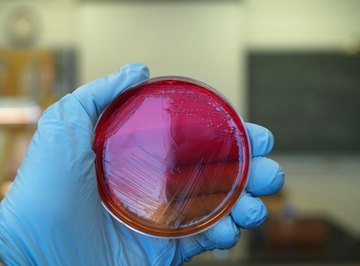
All living things require a way to produce energy in order to power the metabolic, synthetic and reproductive machinery inside their cells. Ultimately, every living thing uses the molecule ATP (adenosine triphosphate) for this purpose.
In turn, to derive energy from molecules, those molecules, called nutrients, must be easy to find and simple to break down. Glucose fits this description for most life on Earth. Some organisms get glucose by digesting what they eat; others have to make it or make other carbohydrates.
Far under the ocean's surface, where pressures are extreme and nutrients scarce, certain communities of organisms are able to not merely survive but thrive. Not by accident, in fact, they do so while clustering around hydrothermal vents, openings in the sea floor that emit extreme heat and chemicals that many species cannot tolerate (like miniature volcanoes). These chemosynthetic organisms represent both a curiosity and a triumph of evolution in terms of how they make food.
How Organisms Get Food
Organisms can be classified as prokaryotes, the cells of which lack membrane-bound organelles and reproduce asexually, or eukaryotes, whose cells have their DNA enclosed in nuclei and feature a host of membrane-bound organelles in the cytoplasm. Among those membrane-bound organelles are mitochondria and, in plants, chloroplasts.
Mitochondria allow all eukaryotes to break down glucose aerobically to carbon dioxide, water and energy; chloroplasts allow plants to build glucose from carbon dioxide since they cannot ingest it.
Chemosynthesis is the derivation of carbon from carbon dioxide plus energy from other agents, described below. Chemosynthesis is thus closely related to photosynthesis. In fact, together, chemosynthetic organisms and photosynthetic organisms make up the autotrophs, or the class of living things that make, rather than ingest, their own food. These can be either prokaryotes or eukaryotes, as you'll see.
What Are Autotrophs?
Autotrophs are organisms that can produce, or synthesize, their own food as long as a source of carbon and a source of energy is present. This minimal source of carbon is usually in the form of carbon dioxide (CO2), a molecule that is virtually everywhere on and above the planet.
Humans and other animals excrete it as waste. Plants and other autotrophs use it as fuel, maintaining one of nature's more grand and definitive biochemical cycles.
Plants are the most familiar type of autotroph, but various others dot the global biosphere, often far from human eyes. Algae, phytoplankton and certain bacteria are autotrophs. In particular, the bacteria that can survive deep in the sea are of special interest because of their chemosynthetic metabolism.
Chemosynthesis: Definition
Chemosynthesis is a process by which energy is derived via the microbial mediation of certain chemical reactions. The source of energy for chemosynthesis is energy liberated from a chemical reaction (the oxidation of an inorganic substance) rather than energy harvested from sunlight or other light.
The carbon source remains CO2, and oxygen (as O2) must be present to operate on the inorganic molecule, but that inorganic molecule may be hydrogen gas (H2), hydrogen sulfide (H2S) or ammonia (NH3), depending on the environment in question. Whatever carbohydrate is formed for the cell's use will have the form (CH2O)N, as this is true of all carbohydrates by definition.
One chemosynthesis equation depicts the conversion of carbon dioxide to carbohydrate as hydrogen sulfide is oxidized to water and sulfur:
CO2+ O2 + 4 H2S → CH2O + 4 S + 3 H2O
Chemosynthetic Bacteria and Life Examples
Some organisms can survive in the vicinity of sea floor vents, because these emit water with a temperature of around 5 to 100 °C (41 to 212 °F). This is not precisely warm and welcoming, but inconsistent and sometimes violent heat is better than no heat at all if you have the right enzymatic equipment.
Some "bacteria" in these so-called hydrothermal vent communities are actually Archaea, prokaryotic organisms closely related to bacteria (and formerly called archaebacteria). One example is Methanopyrus kandleri, which tolerates very salty and very warm environments with unusual ease. This species gets energy from hydrogen gas and releases methane (CH4).
References
About the Author
Kevin Beck holds a bachelor's degree in physics with minors in math and chemistry from the University of Vermont. Formerly with ScienceBlogs.com and the editor of "Run Strong," he has written for Runner's World, Men's Fitness, Competitor, and a variety of other publications. More about Kevin and links to his professional work can be found at www.kemibe.com.
Photo Credits
Bacteria Colonies image by ggw from Fotolia.com
